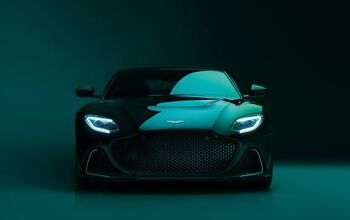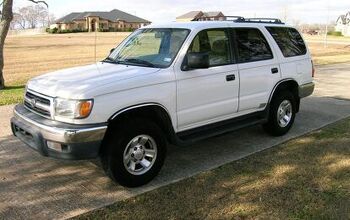2022 Lexus LX 600: Return of the Toyota Land Cruiser

When Toyota announced that the Land Cruiser wouldn’t be coming back to the United States, off-road people shrugged and got back into their clapped-out 4Runners. Despite being incredibly capable wherever pavement is in short supply and having a pedigree that rivals Jeep’s Wrangler, the Land Cruiser is a prohibitively expensive vehicle. Toyota’s penchant for overbuilding vehicles merged with the model’s luxurious bent, resulting in a product that retailed at $87,030 before adding a single option, and sales volumes reflected this.
It was just too rich for most Americans and sales suffered as a result. But Lexus has confirmed the Cruiser-based LX will be returning and recently teased the new model’s next-generation online. While the manufacturer hasn’t confirmed that the 2022 Lexus LX 600 will be a rebadged version of Toyota’s off-road emperor, literally every generation of the LX series has been.
The LX 450 was basically J80, the LX 470 was the J100, and the LX 570 was the J200. So there’s no reason to assume that the fourth-gen Lexus will be anything other than a dressed-up Land Cruiser J300 series we saw in June.
For our market, that presumably means the LX 600 will be arriving with a new twin-turbo, 3.5-liter V6 that’s supposedly better than the 5.7-liter V8 that went into the previous model. Lexus customers can expect spec sheets listing 409 horsepower and 479 lb-ft of torque. A hybrid variant has also been rumored, with the LX borrowing powertrains from the Toyota Tundra. However, nothing has been confirmed.
Four-wheel drive is absolutely going to be standard, as will three rows of seating, multiple terrain modes, and a 10-speed automatic transmission. But Lexus isn’t giving us much to go on and remaining absolutely silent since the LX 600 is supposed to make its official debut on October 13th.
Adventure awaits. Experience the all-new on October 13 at 12:30 p.m. EST. https://t.co/jdJ8o9A4Ae pic.twitter.com/vuPozItX4U
— Lexus (@Lexus) October 8, 2021
[Image: Lexus]

A staunch consumer advocate tracking industry trends and regulation. Before joining TTAC, Matt spent a decade working for marketing and research firms based in NYC. Clients included several of the world’s largest automakers, global tire brands, and aftermarket part suppliers. Dissatisfied with the corporate world and resentful of having to wear suits everyday, he pivoted to writing about cars. Since then, that man has become an ardent supporter of the right-to-repair movement, been interviewed on the auto industry by national radio broadcasts, driven more rental cars than anyone ever should, participated in amateur rallying events, and received the requisite minimum training as sanctioned by the SCCA. Handy with a wrench, Matt grew up surrounded by Detroit auto workers and managed to get a pizza delivery job before he was legally eligible. He later found himself driving box trucks through Manhattan, guaranteeing future sympathy for actual truckers. He continues to conduct research pertaining to the automotive sector as an independent contractor and has since moved back to his native Michigan, closer to where the cars are born. A contrarian, Matt claims to prefer understeer — stating that front and all-wheel drive vehicles cater best to his driving style.
More by Matt Posky
Latest Car Reviews
Read moreLatest Product Reviews
Read moreRecent Comments
- Corey Lewis It's not competitive against others in the class, as my review discussed. https://www.thetruthaboutcars.com/cars/chevrolet/rental-review-the-2023-chevrolet-malibu-last-domestic-midsize-standing-44502760
- Turbo Is Black Magic My wife had one of these back in 06, did a ton of work to it… supercharger, full exhaust, full suspension.. it was a blast to drive even though it was still hilariously slow. Great for drive in nights, open the hatch fold the seats flat and just relax.Also this thing is a great example of how far we have come in crash safety even since just 2005… go look at these old crash tests now and I cringe at what a modern electric tank would do to this thing.
- MaintenanceCosts Whenever the topic of the xB comes up…Me: "The style is fun. The combination of the box shape and the aggressive detailing is very JDM."Wife: "Those are ghetto."Me: "They're smaller than a Corolla outside and have the space of a RAV4 inside."Wife: "Those are ghetto."Me: "They're kind of fun to drive with a stick."Wife: "Those are ghetto."It's one of a few cars (including its fellow box, the Ford Flex) on which we will just never see eye to eye.
- Oberkanone The alternative is a more expensive SUV. Yes, it will be missed.
- Ajla I did like this one.


































Comments
Join the conversation
The twin turbo engine will be way more complicated, cost thousands more to manufacture, require Premium, create more heat underhood and not have as good a powerband as the V8 down low, and not last nearly as long. But get 1 mpg better to meet CAFE regulations. Progress!
As I understood from comments it is made for 3rd world countries (or 2nd world countries like Russia which lacks roads in most of the country) and not for US customers since there are a plenty of paved roads in USA. May be Canadians similar to Russians will find these kind of trucks useful?